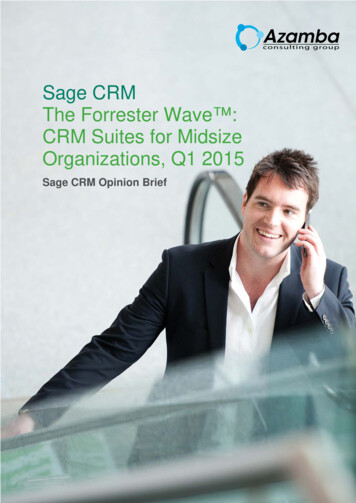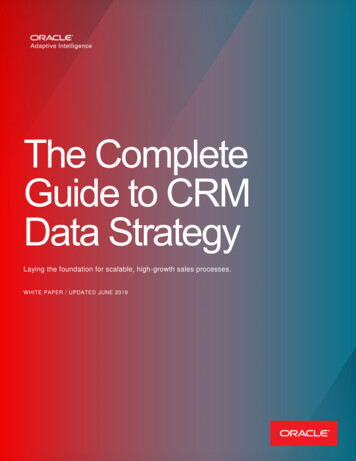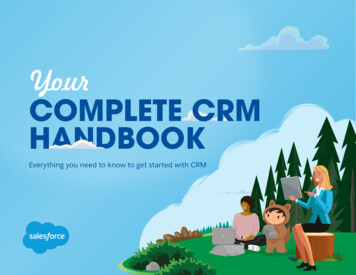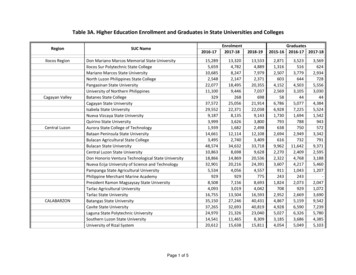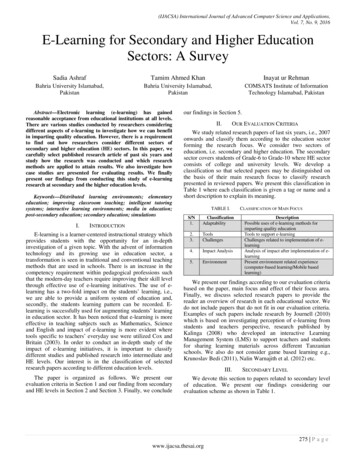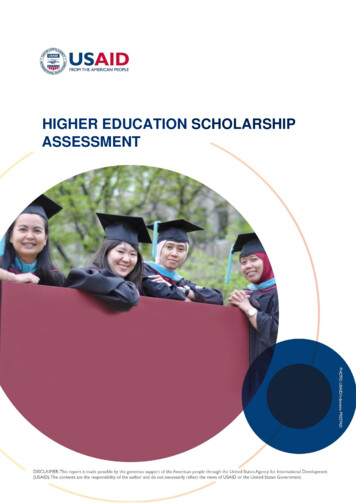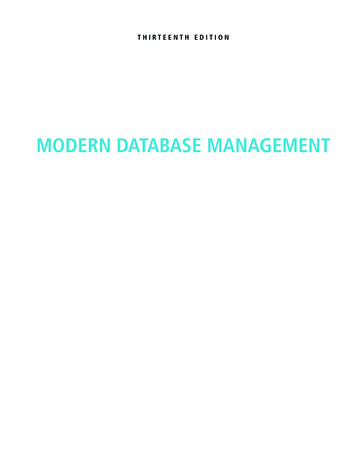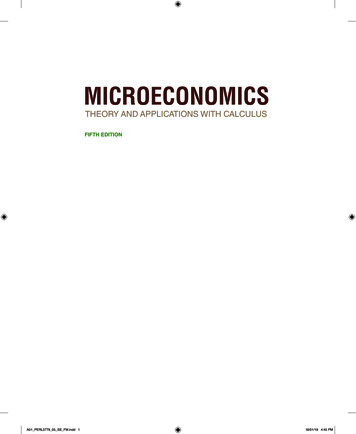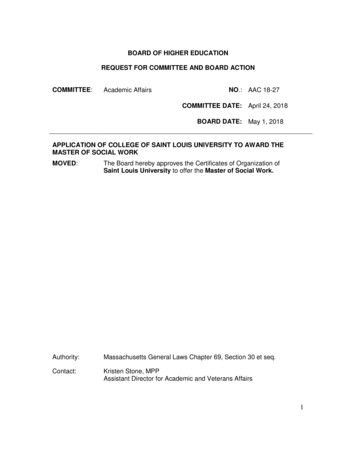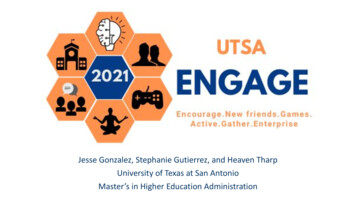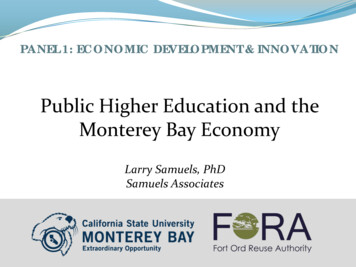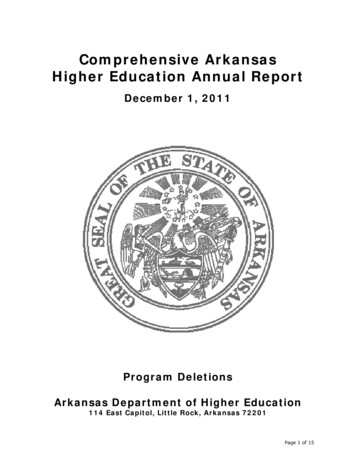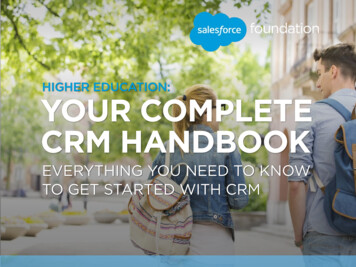
Transcription
HIGHER EDUCATION:YOUR COMPLETECRM HANDBOOKEVERYTHING YOU NEED TO KNOWTO GET STARTED WITH CRM
IntroductionWHAT IS CRM?CRM is much more than a buzzy acronym that’s been tossedaround the business and sales world for the past decade orso, and higher education institutions are putting it to use forrecruiting, student success, advancement, marketing, and more.C-R-M stands for “Constituent RelationshipManagement.”With a CRM application, there’s no secret formula. It simplymanages most of your critical constituent information so youcan see it all in one place. Without leaving the app, you can viewcontact info, follow up via email or social media, manage tasks,and track success metrics, among other benefits. Implementingthe right CRM can increase institutional efficiency. You canimprove relationships with prospects, students, alumni, faculty,staff, and corporations.Is it time to invest in a CRM?The contents of this e-book will help you determine that. Overthe next four chapters, we will examine the following topics: Signs your school needs a CRM How CRM can improve your productivity and efficiency Building your CRM strategy How to maximize your ROIFirst up, the 7 signs your business needs a CRM.Table of Contents03 Signs Your School Needs a CRM05 How CRM Improves Efficiencyand Productivity09 How to Craft a CRM Strategy12 Maximizing Your ROI14 Conclusion2/
Chapter 1SIGNS YOUR SCHOOLNEEDS A CRMRelationships in higher education can begin in a plethora ofways – from a prospective student requesting informationon your website to gift officers calling on alumni. Manydepartments may keep track of the status of tasks, transactions,and notes on an Excel spreadsheet, but this simply doesn’tscale and is very inefficient. As your school’s operations growand you need to share information across departments andwith peers, this sort of record-keeping can’t do what you needanymore. Here are some warning signs it’s time to trade inthose old ways and start managing your relationships moreeffectively:1. There’s no single source for information.Storing constituent relationship information in more thanone location, such as a spreadsheet or notes stuck to yourcomputer, puts your teams at a disadvantage. They lack asingle view of every constituent interaction, request, donation,etc.2. There’s little or no visibility.Not only do you lack visibility into how your constituent groupsare connecting with your school, you also lack insight into whatyour different departments are doing. This makes it difficult tohelp them be successful – and keep them accountable.With today’s constituentexpectations and a needto be more efficient, thissort of record-keepingsimply can’t do what youneed anymore.3/
3. Reports are tedious and painful.Generating reports and analytics of your team’s monthly progress wouldbe ideal. But creating reports manually is cumbersome, often resulting in notracking at all.4. You are losing data.It’s hard for you to schedule follow-ups with prospects and potential donors.Great meetings happen on the road, but teams don’t always transfer theirnotes and important details get lost, especially if staff leave the institution.5. It’s hard to stay in touch on the go.Your recruiters and gift officers are out in the field, meeting with prospectivestudents and donors and discovering valuable info. But all this new data getsstored on handwritten notes or in files on personal computers, instead ofbeing shared with the team.6. Every stakeholder is treated the same.Your communications are not targeted or personalized. For example, youdon’t target potential donors based on their value to the school. Rather, youare sending the same messages to donors in very different stages of thegiving process, as well as in different segments and geographies.7. You lack a plan to scale fast.At a time where you have to do more with less, are you using your staff’s timeefficiently? Are they spending so much time with manual processes that theycan’t work more strategically? If someone left, would you lose all the informationabout their work?Does your institutionneed a CRM?Not sure if your institution is ready for a CRM?If you check any of the following boxes, a CRMcould dramatically improve your institution’sperformance.There’s no single source for informationThere’s little or no visibilityReports are tedious and painfulYou are losing dataIt’s hard to stay in touch on the goEvery stakeholder is treated the sameYou lack a plan to scale fastIf any of these apply to your school or one of your departments, don’t despair.These are exactly the issues that a CRM system can address. Next up, let’s take alook at how a CRM makes your institution more efficient and productive.4/
Chapter 2HOW CRM IMPROVESEFFICIENCY ANDPRODUCTIVITYYou probably know the old saying, “there never seem to beenough hours in the day.” This is especially true in highereducation.When you use your time more effectively and efficiently, itbecomes much easier to meet and exceed success metrics.Colleges and universities that succeed do so by creating openand efficient lines of communication internally to ensure everydepartment is on the same page and has access to the sameinformation. That is where a CRM application comes in.Break Down SilosBridging the data gap between departments can bechallenging for any organization, let alone a complex highereducation institution. Siloed departments often struggle withthings like: Inability to route prospective student leads to theappropriate team member Lack of information on potential donors Inability to connect students with the right departmentfor fast support Poor visibility into constituent information and lack ofconstituent engagement.“Our student recruiterproductivity has tripledwith Salesforce. Whatused to take weeksor months now takesminutes.”-Algonquin College5/
A CRM app facilitates collaboration amongst faculty andstaff so they can share files, team up on cases or tickets, anddiscuss projects – all from within a single system. Plus, it tracksactivity so you can visibly measure your success.Time to Get Stuff DoneObviously, people need time to do their jobs well. But byeliminating some time traps, you can significantly improveoperational efficiency and productivity. Here are some thingsthat can be easily fixed:In a mobile world, many of your recruiters and advancementprofessionals are out on the road as are other staff members.Having the ability to access a constituent’s record, submitprospective donor along the lifecycle from their phone ortablet, wherever they are, saves a ton of time and improves theconstituent experience. Automation of repetitive tasks gives the team more time toconcentrate on building relationships Providing one channel for teams to share information andconnect eliminates endless email loops and phone tag.The right CRM system syncs with mobile devices anywhere,anytime via the cloud, so the entire team is on the same pageand has the most current information at their fingertips.a report, take notes, send out information, or move a“A CRM allows an institution to storedata on constituents so information isready at each interaction.6/
Better IntelligenceInformation is key. But thechallenge is gathering,organizing, and makinginformation actionable. Imagineif you could unleash siloed datafrom back office systems, likeyour SIS and LMS, across yourentire campus to create a true360O view of each constituent- and then be able to takeimmediate action on whatyou’ve learned.CRMs help solve this problemby collecting valuable prospect,student, alumni, faculty, andstaff data, including: Prospective student historyCurrent student status andpreferencesConstituent social mediapresencePast interactions withalumni and donorsConstituent relationshipmapsStudent case historyNow that you’ve seen thevalue of a CRM system, let’sinvestigate best practices forgetting a CRM strategy in place.7/
DON’T FORGET TOTHINK MOBILEThe Mobile CampusAs you consider CRM solutions, it’s importantto consider that the modern recruiting team, forexample, is no longer confined to their desks for 8hours a day. They are always on, always connected,and incredibly mobile. When considering any newtool, including a CRM, you should make sure thetechnology enhances this shift in productivity, andfits into your team’s existing workflows.Mobile CRM ToolsWhen considering CRM tools, you’ll notice that arare few have functional mobile components. Makesure the technology you are considering does notjust add mobile functionality as an afterthought.Solutions like Salesforce were built mobile-firstwith a team’s productivity in mind. Designed withapps and features that streamline organizationalprocess and enhance everyday operations, a truemobile CRM can mean the difference between asolution that merely helps your institution, and onethat revolutionizes it.8/
Chapter 3HOW TO CRAFTA CRMSTRATEGYBuilding a successful CRM system isn’t just aboutchoosing the right technology, as significant as that is.You also need the right plan in place from a businessperspective. Here are seven basic steps to build awinning plan:1. Define Your VisionSome people dismiss vision statements as a waste oftime, but successful leaders know the value of having aclear, repeatable, action-oriented vision that your teamcan rally around. Your vision can be many things, fromincreasing graduation rates, to redefining educationfor non-traditional students. Make it both aspirationalenough to have an impact, and clear enough that theentire institution can understand it.2. Define Your StrategyStrategy is what makes your vision achievable. Say youwant to be the largest education institution. Do you dothis by changing recruiting processes, or offering uniquestudent services, or by revamping your marketing plan?Building a successfulCRM system isn’t justabout choosing theright technology, assignificant as that is.You also need the rightplan in place from aninstitutional perspective.9/
3. Define Your Organizational ObjectivesBuilding your CRMstrategy.Set yourself up for success by building acomprehensive CRM strategy. Take thefollowing steps to hit the ground running.Organizational objectives are where vision and strategy get translated into theday-to-day work. A common mistake when implementing a new CRM systemis to replicate in it all the old objectives and processes, complete with theirinefficiencies. Instead, view your implementation as an opportunity to reviewand optimize how you work.4. Get Your Team On BoardExecutive sponsorship is vital for your CRM vision, strategy and objectives,and for a successful rollout. A lack of executive sponsorship is one of the topfive contributing factors to CRM failure.5. Identify the MetricsDefine Your VisionDefine Your StrategyDefine Your Organizational ObjectivesGet Your Team On BoardIdentify the MetricsPrioritize Your InitiativesDefine Your Roadmap“You can’t manage what you can’t measure” is an adage attributed to manybusiness thinkers – and it applies to higher education as well. Metrics shouldbe visible to everyone, and this means creating dashboards for all levels ofthe institution, from recruiters and managers, to professors and deans, to thepresident of the university.6. Prioritize Your InitiativesYou’re not going to get everything done at once, so decide what’s mostimportant to deliver first. Training is often the priority, so everyone is ready touse the new CRM system as soon as it is available.7. Define Your RoadmapYou shouldn’t look at building an effective CRM system as a “big bang” event.Yes, a successful rollout is vital, but being able to deliver enhancements andnew features after you go live is equally important. Plan beyond launch dayand consider what other capabilities you need to deliver for the institution.Now that your CRM system and strategy are in place, it’s time to see the bestways to measure and maximize the technology.10 /
Customer Spotlight:St. NorbertCollegeWhen St. Norbert College looked for away automate manual processes and ridthemselves of paper forms, they turnedto Salesforce. The school replaced Excelspreadsheets, Access databases, and over215 SQL scripts with native Salesforcefunctionality, giving their admissions,advancement, and advising teams a360O view of each consistent. St. Norbertrolled out a mobile app for gift officers,streamlined their recruiting process, andcut their use of paper in the admissionsprocess by 88%.Read the full story here ›“The move to Salesforce has madeour teams more efficient. We wantto replicate this success in otherdepartments across campus.”– Ravi Agarwal, Director of Enterprise Applications11 /
Chapter 4MAXIMIZINGYOUR ROIHere are several best practices to rememberwhen working to maximize your ROI, fromCRM Search’s Karen D. Schwartz:Choose a Cloud-BasedCRM SolutionAll major CRM vendors offer cloud versions oftheir apps. Choosing this software as a service(SaaS) model means schools no longer haveto deal with things that on-premise CRM appsdemand, like servers, software issues, andnew version upgrades.Integrate with Applications thatProvide ValueTake advantage of the new business andsocial applications that are out there, andintegrate them with your CRM system. Theseinclude marketing automation and accountingsoftware, plus key social tools, which allowyour school to follow people, information, andgroups on social networks, and capture realtime data.Take advantage of thenew business and socialapplications that are outthere, and integrate themwith your CRM system.12 /
Allow for Mobile IntegrationMake everything accessible onmobile devices for your staff sothey can work on the road —things like reviewing applications,correspondence, managingcontacts, and helping studentsin need. The integration shouldalso ideally work with back-officesystems, social networks, and webconferencing.And so you are fully covered,here are some practices to avoidwhen working to maximize yourCRM ROI, from CRM Buyer’
CRM HANDBOOK. CRM is much more than a buzzy acronym that’s been tossed around the business and sales world for the past decade or so, and higher education institutions are putting it to use for recruiting, student success, advancement, marketing, and more. C-R-M stands for “Constituent Relationship Management.” With a CRM application, there’s no secret formula. It simply manages
